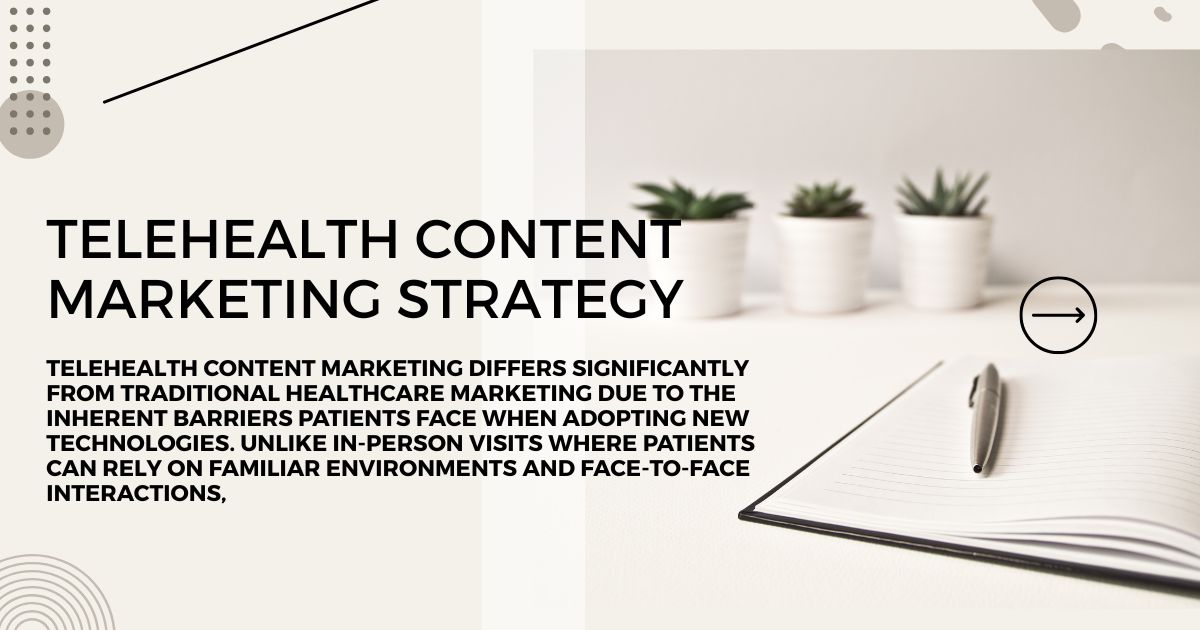
The health care system has made a digital change that seemed impossible a decade ago. Telehealth content services have evolved from a niche service for an important part of modern health care distribution, with the patient’s adoption rate 11% more than 85% by 2023 to 2023. This dramatic change has created unique opportunities for health care professionals to reach and serve patients through innovative digital channels.
For Telehaalth suppliers, traditional marketing methods are reduced to meet unique challenges with the distribution of virtual care. Patients need education about new techniques, assurances on the quality of care and guidance through unknown processes. This is the place where strategic material marketing becomes invaluable server both as a trusting mechanism that builds the difference between traditional health experiences and digital innovation.
This extensive guide explains how telecommunications organizations can benefit from digital media and material marketing to create a patient’s confidence, increase the frequency of adoption and establish themselves as leaders in the developed health services scenario. Whether you are launching a new Telehaalth service or wanting to adapt an existing program, you will discover proven strategies, practical strategies and examples of the real world that have average results.
The health system’s expertise and the intersection of digital media provides unique opportunities to educate, link and serve patients in ways that were impossible in the past. Towards the end of this post, you will have a complete framework for developing a marketing strategy for telehaal material that not only attracts patients, but also improves health results through better communication and education.
Understanding the Telehealth Content Marketing Landscape
Marketing of telecommunications health content varies greatly from traditional marketing of health services, as patients with underlying obstacles occur when they use new techniques. Unlike personal visits, where patients can rely on familiar environment and interactions face -to -face, telecommunications health requires patients to navigate new platforms, depend on unknown procedures and optimize expectations of health care distribution.
The primary challenge lies in addressing the patient’s concerns before being hindered in adoption. General hesitation includes technology anxiety, confidential concerns, questions about the quality of care and uncertainty about insurance coverage. Material marketing addresses these concerns by offering educational resources, success stories and clarification of processes and benefits.
Digital media acts as the right vehicle for Telehland marketing as it promotes service nature. Patients connected to the Online Telehland content are already demonstrating comfort with digital platforms, making them an ideal candidate for virtual care services. This adjustment between marketing medium and service distribution creates a natural progress from consciousness to adoption.
The regulatory environment around health services marketing adds another layer of complexity. HIPAA Sami -response, FDA guidelines and state licensing need all affect how telecommunications suppliers can communicate with potential patients. Successful material marketing strategies navigate these rules, while still providing hypnotic, educational and attractive materials that patients increase procurement and storage.
Building Your Telehealth Content Foundation

Audience Segmentation and Persona Development
Effective telehealth content marketing begins with deep understanding of your target audiences. Primary patient demographics for telehealth services vary widely, from tech-savvy millennials seeking convenience to older adults managing chronic conditions who need additional support navigating digital platforms. Each segment requires tailored messaging and content formats.
Digital media consumption patterns differ significantly across age groups and health conditions. Younger patients may prefer video content on social platforms, while older adults might respond better to email newsletters with clear, step-by-step guides. Understanding these preferences allows you to distribute content through the most effective channels for each audience segment.
Caregivers represent another crucial audience segment often overlooked in telehealth marketing. Adult children researching telehealth options for aging parents, spouses managing family healthcare decisions, and professional caregivers all influence patient adoption decisions. Creating content that addresses their specific concerns and information needs can significantly expand your reach and impact.
Healthcare providers and staff also require content support as they adapt to telehealth workflows. Internal content marketing matters ensure consistent messaging, reduces staff anxiety about new technologies, and creates advocates who can confidently recommend telehealth services to appropriate patients.
Content Pillars for Telehealth Success
Education material forms the foundation stone for effective telecommunications marketing. Patients need extensive information on how Telehaalten works, what is expected during virtual visits and how to prepare for successful appointments. This material will address technical requirements, contract logistics and clinical processes in the language available to patients with different levels of health skills.
Confidential materials deal with emotional and psychological obstacles for the adoption of Telehaalt. Patient glue, supplier information, security explanations and results help to establish reliability in data and reduce the fear of virtual care. This type of material is especially important for patients with severe health conditions who can hesitate to try virtual consultation.
Practical support material provides action -related guidance that improves the success rate for the patient with telecommunications services. Technology reduces the friction in the patient’s experience by demonstrating their commitment to training programs, troubleshooting guides, insurance navigation assistance and preparation checklist -the success of the patient.
Clinical expertise content shows the depth and quality of care available through Telehealth services. Status -specific information, treatment explanation and health learning material establish their supplier as reliable health managers by improving the patient’s health skills and engagement.
Leveraging Digital Media Channels for Maximum Impact
Video Content Strategy
Video content excels at demonstrating telehealth processes and reducing patient anxiety about unfamiliar experiences. Virtual appointment walkthroughs show patients exactly what to expect, while provider introduction videos help establish personal connections before the first appointment. These visual explanations are particularly valuable for patients who learn better through demonstration rather than written instructions.
Live streaming capabilities enable real-time patient education sessions, Q&A forums, and virtual health workshops. These interactive formats allow patients to ask specific questions and receive immediate answers, building confidence in telehealth services while showcasing provider expertise. Recording these sessions creates evergreen content that continues providing value long after the initial broadcast.
Short-form video content on social platforms can address common telehealth questions quickly and memorably. Quick tips for optimal video call setups, brief explanations of telehealth benefits, and patient success story highlights work well in formats popularized by platforms like TikTok and Instagram Reels.
Patient privacy considerations require careful planning for video content. Anonymized patient testimonials, provider-only demonstrations, and educational content featuring actors rather than real patients help maintain HIPAA compliance while still providing engaging visual content.
Written Content and SEO Strategy
Blog content serves multiple purposes in telehealth marketing, from search engine optimization to patient education. Long-form articles addressing common health questions, telehealth guides, and condition-specific information help establish your organization as a reliable health information source while improving search engine rankings.
Search engine optimization for telehealth content requires understanding how patients search for virtual care options. Keywords related to specific conditions combined with telehealth terms, location-based searches, and insurance-related queries all represent opportunities to capture patients actively seeking virtual care solutions.
Email marketing remains highly effective for telehealth patient communication. Newsletter content can include appointment reminders, health tips, new service announcements, and educational content tailored to specific patient populations. Segmented email campaigns allow for personalized communication that addresses the unique needs of different patient groups.
Patient portal content extends the educational mission beyond marketing into ongoing patient engagement. Resources available through secure patient portals can include detailed preparation guides, post-appointment care instructions, and condition-specific educational materials that support better health outcomes.
Social Media and Community Building
Social media platforms provide opportunities to construct local communities around Telehland services, and address general concerns in public forums. Answers to the patient’s questions help publicly educate the broader audience by demonstrating their commitment to the patient’s support and openness.
Platform -specific strategies maximize the unique abilities of different social networks. LinkedIn materials can target health professionals and decision makers, while Facebook groups form aid society for patients with specific conditions. Instagram Visual content shows the human side of Telehaalth services, while Twitter enables real -time health authorities and tips.
User -related material improves positive patient experiences by providing authentic admiration with potential patients. Encouraging satisfied patients to share their telecommunications experiences makes powerful social evidence by reaching your content through the patient network.
Crisis communication planning becomes important when using social media to market health services. The presence of procedures to address negative response, correct misinformation and handle sensitive patient communication helps protect both patient protection and organizational reputation.
Content Creation Best Practices for Healthcare
Regulatory Compliance and Ethical Considerations
Requirements for hipaa compliance affect significantly that affect the production and distribution of telecommunications material. All marketing material should avoid the identity of the patient, share unauthorized health information and violation of the patient expectations. It extends to interaction between social media, marketing practices for e -posts and tracking of website analyzes.
Medical accuracy standards require careful review procedures for all clinical materials. Licensed health professionals underwent educational materials, treatment information and health claims, and ensure accuracy by reducing responsibility risk. Regular materials help maintain accuracy in the form of audit medicine knowledge and best practice.
The ideas of informed consent affect how patients with patients and success can be used in marketing materials. Clear consent processes, anonymous procedures and clarification of patient rights help to ensure moral use of the patient’s experiences with marketing materials.
Advertising rules vary from state and service types, which affects how telecommunications services can be promoted. Understanding the scope of practice boundaries, license needs and regulations on the education of intermediate trade helps to ensure that all applicable laws and professional standards ensure compliance with professional standards.
Measuring Content Marketing Success
Patients provide direct evidence of metric marketing efficiency. Tracking that helps customize content agreement, new patient registration and service survey material strategy and resource allocation. Atribution modeling becomes especially important when the patient interacts with the point of touch before they change patients.
Engagement Analytics suggests how well the material resonates with target groups. Time reading of articles, degree of completion for video, open prices on e -post and interaction between social media indicates the quality and relevance of the material. These calculations help to identify which subjects, format and distribution channels do the best work for different public sections.
Improvement in patient results associated with educational material shows the broad value of material marketing beyond patient collection. Tracking agreement helps to determine the clinical effect of marketing patient satisfaction points between patients related to appearance, treatment compliance and patients related to educational material.
Returns on investment calculation should be for both patients’ procurement costs and lifelong patient value. Telecommunications patients associated with educational materials often show high retention and better results, leading to an increase in their long -term value for the organization.
Advanced Strategies and Emerging Opportunities
Personalization and Automation
Marketing automation platforms enable personalized patient communications at scale. Triggered email sequences can guide new patients through telehealth onboarding processes, while behavioral triggers can deliver relevant educational content based on patient interests and engagement patterns.
Artificial intelligence tools are beginning to enhance telehealth content marketing works through chatbots that answer common questions, content recommendation engines that suggest relevant resources, and predictive analytics that identify patients most likely to benefit from telehealth services.
Dynamic content personalization adapts marketing messages based on patient demographics, health conditions, and previous interactions. This approach improves content relevance while reducing the manual effort required to maintain multiple audience-specific campaigns.
Integration with electronic health records enables more sophisticated patient communication strategies. Treatment reminders, follow-up care instructions, and condition-specific educational content can be automatically triggered based on clinical data, improving both patient outcomes and engagement.
Learn how Content Marketing can be your business weapon
Partnerships and Collaboration

Healthcare provider partnerships expand content optimize reach while sharing development costs. Collaborative educational webinars, shared blog content, and joint social media campaigns help smaller telehealth practices compete with larger organizations while providing patients with more comprehensive resources.
Technology platform partnerships create opportunities for co-marketing educational content. Telehealth software vendors, medical device manufacturers, and health app developers often welcome partnerships that help educate patients about digital health tools and processes.
Community organization partnerships help reach underserved populations who may benefit significantly from telehealth services. Collaborating with senior centers, community health organizations, and patient advocacy groups creates trusted channels for telehealth education and adoption.
Academic partnerships with medical schools and nursing programs can provide content creation resources while establishing your organization as an educational leader in telehealth innovation. Student projects, research collaborations, and clinical rotation programs all create content opportunities.
Overcoming Common Telehealth Marketing Challenges
Patient technology barriers require extensive educational support that goes beyond basic marketing materials. Step-by-step technology guides, opportunities for exercises and resources with technical aids help ensure that patients can successfully engage with Telehaalth services regardless of the technology experience level.
Insurance cover confusion represents a significant obstacle to the adoption of telecommunications. Clearly, regularly updated information helps patients make informed decisions on telecommunications health services on coverage policy, invoicing procedures and cost comparison. This material requires frequent updates because insurance and rules continue to develop.
If the clinical employees do not fully support virtual care initiatives, the supplier suspects may reduce the marketing efforts for Telehaalt. Internal marketing of content that educates suppliers about Telehland benefits, addresses the concerns and provides implementation help, and helps create an integrated approach to patient communication.
The challenges of quality views require active communication on clinical standards for Telehland, supplier qualifications and results data. When telecommunications health is and is not suitable, it is that when you create confidence in the quality of virtual care, you help determine appropriate patients.
Your Next Steps in Telehealth Content Marketing
The future of delivery of health services is Rapid Digital, which requires material marketing skills for success. Now, organizations that invest in extensive material strategies will be in a better place to serve patients, effectively compete and be suitable for continuous changes in health care models.
Start by revising your current material assets and identifying the intervals for patient training, trust building and practical auxiliary material. The most common patient should prioritize the construction of material based on questions and obstacles that have come before you in your telecommunications practice. Remember more stability and quality than volume when creating patient confidence and commitment.
Experienced health material assesses partnerships with the creators who understand both regulatory requirements for digital media and health care. Investment in professional material development often pays dividends through better patient results, high baby prices and strong competitive positions.
Digital media will continue to develop, bring new opportunities to increase the results through the patient’s education, engagement and Telehland services. Organizations that embrace material marketing as a main component in their Telehland strategy, they will find themselves better equipped to serve patients, increase their practice and contribute to the ongoing changes in the health care distribution.


















No Comments